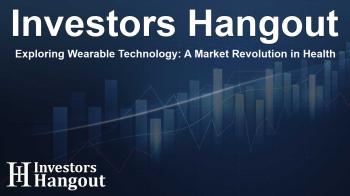Exploring Wearable Technology: A Market Revolution in Health

Transforming Health: The Rise of Wearable Technology
The wearable technology market has gained immense traction as it is poised for remarkable growth, notably set to increase by an estimated USD 99.4 billion between 2025 and 2029. This surge is not just a number; it represents how profoundly these innovations are impacting our daily lives, especially in health and fitness.
A Market Driven by Consumer Needs
Wearable devices have become essential for various consumer groups, ranging from fitness enthusiasts like runners and cyclists to those who prioritize health monitoring through smart gadgets. The integration of advanced technologies such as AI is driving this market, prompting manufacturers to innovate continuously. Imagine a smartwatch that tracks your health metrics in real-time or smart clothing that adapts to your body's needs—this is not science fiction; it's the present reality.
The Role of Artificial Intelligence
Artificial intelligence is reshaping wearable technology. This innovation is not just about creating more advanced devices but enhancing existing technology for better user experience and accurate monitoring. For instance, AI can analyze large datasets from wearables to provide users with personalized health insights, allowing them to make informed decisions about their lifestyle and fitness routines.
Key Challenges in the Market
However, these advancements do not come without challenges. The proliferation of counterfeit products poses substantial risks to consumers and genuine brands. Major names in wearables, such as Apple and Samsung, face significant drawbacks as cheaper replicas flood the market, potentially undermining the integrity and growth of authentic wearable technology.
Market Drivers: Why Wearable Technology?
The increasing demand for wearable technology in the healthcare sector is noteworthy. Devices providing timely health information are crucial for both patients and healthcare professionals. Moreover, with the rising elderly population, wearables offering features like fall detection contribute significantly to their safety and wellbeing, ensuring that they can live independently.
Embracing Connectivity
Connectivity plays a vital role in the efficacy of wearables. Technologies such as Bluetooth, Wi-Fi, and NFC enable seamless communication between devices. This feature is particularly appealing to consumers who desire convenience and efficiency—think being able to track your health metrics while simultaneously interacting with friends through your smart device.
Segments of the Market
The wearable technology market encompasses various categories, ranging from wrist-wear like smartwatches to eyewear, footwear, and even smart clothing. Each segment offers unique functionalities catering to specific consumer needs, whether for sports, health, or lifestyle integration. These innovations are paving the way for a healthier lifestyle and enhancing user engagement with technology.
Future Prospects of Wearable Technology
Looking forward, the landscape of wearable technology is set to expand. New products are emerging that not only perform basic functions but also engage with users on a deeper level. As more people become health-conscious, the wearables market will likely shift its focus towards more advanced features, such as real-time health tracking and integration with telehealth services.
With more consumers embracing these devices, companies are innovating faster, resulting in a cycle that fuels demand. By creating wearables with low-power consumption and high performance, manufacturers are ensuring longer battery life and enhanced user satisfaction. Additionally, the convergence of wearable tech with emerging technologies such as augmented reality and personalized health monitoring apps will define the future of this rapidly evolving market.
Frequently Asked Questions
What is the expected growth rate of the wearable technology market?
The wearable technology market is projected to grow by approximately USD 99.4 billion from 2025 to 2029, with an annual growth rate over 17.3%.
How does AI influence wearable technology?
AI enhances wearable tech by analyzing user data to offer personalized insights, improving health management, and enabling smarter connectivity between devices.
What are some challenges faced by the wearable technology market?
Counterfeit products present a significant challenge, impacting brand integrity and market growth. Additionally, data security concerns may deter some consumers.
What types of products are included in the wearable technology market?
Wearable technology encompasses a wide range of products, including smartwatches, smart rings, fitness bands, head-mounted displays, and IoT-enabled clothing.
How is the healthcare sector leveraging wearable technology?
Wearables are revolutionizing healthcare by providing real-time health monitoring, enhancing patient engagement, and improving disease management and telehealth services.
About The Author
Contact Lucas Young privately here. Or send an email with ATTN: Lucas Young as the subject to contact@investorshangout.com.
About Investors Hangout
Investors Hangout is a leading online stock forum for financial discussion and learning, offering a wide range of free tools and resources. It draws in traders of all levels, who exchange market knowledge, investigate trading tactics, and keep an eye on industry developments in real time. Featuring financial articles, stock message boards, quotes, charts, company profiles, and live news updates. Through cooperative learning and a wealth of informational resources, it helps users from novices creating their first portfolios to experts honing their techniques. Join Investors Hangout today: https://investorshangout.com/
The content of this article is based on factual, publicly available information and does not represent legal, financial, or investment advice. Investors Hangout does not offer financial advice, and the author is not a licensed financial advisor. Consult a qualified advisor before making any financial or investment decisions based on this article. This article should not be considered advice to purchase, sell, or hold any securities or other investments. If any of the material provided here is inaccurate, please contact us for corrections.

